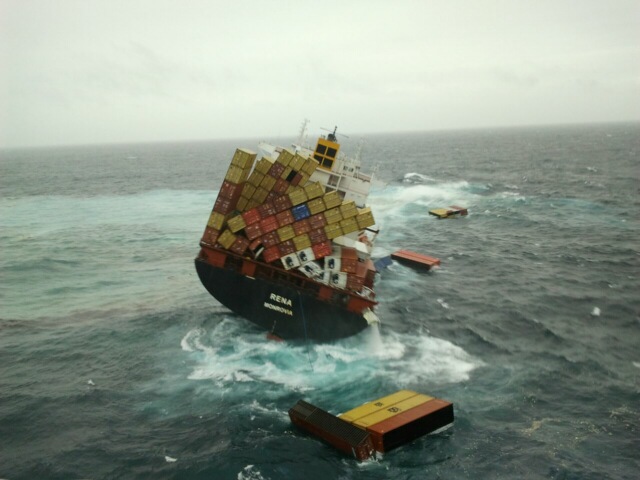The grounding of the Rena in New Zealand
The grounding of the Rena on October 5th and the subsequent inability of the ship-owner and New Zealand maritime authority’s to free the vessel, to stop the fuel from leaking and to avoid the loss of containers foreshadow big future disasters in the field of container shipping.
In 1980 the largest container ships carried up to 2,000 containers, in 1991 up to 4,400, in 2003 the figure increased to 8,800 and in 2007 up to 14,500 containers. Starting from 2013, some container ships from the Danish company Maersk will be able to transport up to 18,000 containers. The “normal” crew size of 19 could further be reduced to 13. The container ships will measure 400 meters in length, 59 meters in width and the containers will be staked up to 73 meters in height. These new container ships will also carry 15,000 to 20,000 tons of bunker fuel however, the exact capacity is confidential. Insurers as well as Search and Rescue services, port stakeholders, maritime experts and some environmental NGOs are all concerned about this endless race to gigantic container ships.
To date, the small world of container ships has already drawn attention because of a number of major accidents:
The MSC Carla split into two off the Azores in November 1997, the same month and year the MSC Rosa M, after breaking down in the Baie de Seine, was rescued and towed at the last minute to the Port of Cherbourg. In 2006, the Rokia Delmas ran aground on the Southern coast of the Isle of Ré. In January 2007 it was the turn of the MSC Napoli to be in trouble in the Channel before she was stranded in Lyme Bay, Great Britain.
Fires which spread from one container to another and release for days on end toxic soot and toxic smoke are very difficult to bring under control even with outside help. Clear illustrations of this issue includes in November 2002 the Hanjin Pennsylvania in the Indian Ocean, in March 2006 the Hyundai Fortune in the Gulf of Aden, and the Charlotte Maersk in the Malacca Strait in July 2010.
Container losses are common during storms: In March 1989 the Perintis lost containers full of insecticides in the Channel. In December 1993, the Sherbro lost 88 containers off the Cherbourg coast. In February 2002 the Lykes Liberator lost 60 containers off the Brittany coast. In February 2006 the CMA-CGM Verdi lost 85 off the Cape Finisterre coastline, the Nedlloyd Mondriaan lost 58 in the North Sea and finally the Otello lost 48 containers in the Bay of Biscay.
Compared to the largest container ships to come, the grounding of the Rena on the Astrolabe reef (1), carrying according to the ship owner’s declaration 1,351 containers and 1,700 tons of fuel, is just a sneak preview. However, one has to add the oil spill damage, the drift and dislocation of lost containers which are going to create problems for navigation safety, fishing activities, as well as spread countless waste, harmful to marine life. The removal of the containers from the holds of the ship, the dismantling and the final assessment of pollution and other impacts will take years. Approaching the Australian port of Cairns, the container ship Bunga Teratai Segu ran aground on a coral reef in November 2000, all pollutants were taken into consideration, including the particles of paint containing TBTs which came off during the grounding. After the clean-up, the Australian Government recommended a monitoring period of 10 years.
It is urgent that the International Maritime Organization and all the other stakeholders impose new rules and precautionary measures to the container ships builders, owners, and crews.
(1) Dumont d’Urville, the French discoverer of the Antarctic, named the reef after his ship L’Astrolabe nearly ran aground on it in 1827.
Sources : Cedre – Centre of Documentation, Research and Experimentation on Accidental Water Pollution – and Robin des Bois
The Rena lodged on the Astrolabe reef – © Maritime New Zealand.
 Imprimer cet article
Imprimer cet article










